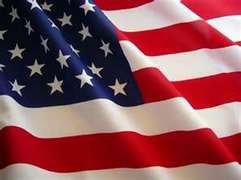
The 4th of July is perhaps the most American of all their holidays because it symbolizes the commencement of the nation. Independence Day has become an important occasion where Americans are able to truly express their freedom.
This day has forever been a favorite for traditions of fireworks, parades, barbecues, beer, picnics, baseball, outdoor parties, public and private events honoring the nation.
Since July of 1777, fireworks have been the most identifiable event for the Fourth of July.
Many people decorate their home with the American flag, which, there is even an United States Flag Code and Rules for displaying the flag outdoors. The United States Flag Code establishes advisory rules as follows:
1. The flag should never be dipped to any person or thing, unless it is the ensign responding to a salute from a ship of a foreign nation.
2. The flag should never be displayed with the union down, except as a signal of dire distress in instances of extreme danger to life or property.
3. The flag should not be used as "wearing apparel, bedding, or drapery",or for covering a speaker's desk, draping a platform, or for any decoration in general (exception for coffins). Bunting of blue, white and red stripes is available for these purposes. The blue stripe of the bunting should be on the top.
4. The flag should never be drawn back or bunched up in any way.
5. The flag should never be used as a covering for a ceiling.
6. The flag should never be used for any advertising purpose. It should not be embroidered, printed, or otherwise impressed on such articles as cushions, handkerchiefs, napkins, boxes, or anything intended to be discarded after temporary use. Advertising signs should not be attached to the staff or halyard.
7. The flag should never be used as a receptacle for receiving, holding, carrying, or delivering anything.
8. The flag should never be used as a receptacle for receiving, holding, carrying, or delivering anything.
9. When the flag is lowered, no part of it should touch the ground or any other object; it should be received by waiting hands and arms. To store the flag it should be folded neatly and ceremoniously.
10. The flag should be cleaned and mended when necessary.
11. If the flag is being used at a public or private estate, it should not be hung (unless at half mast) during rain or violent weather.
12. When a flag is so worn it is no longer fit to serve as a symbol of the United States, it should be destroyed in a dignified manner, preferably by burning. The American Legion and other organizations regularly conduct dignified flag-burning ceremonies, often on Flag Day, June 14.
13. The flag should never touch anything beneath it. Contrary to an urban legend, the flag code does not state that a flag that touches the ground should be burned. Instead, the flag should be moved so it is not touching the ground.
When display your flag outdoors, the rules state:
1. When the flag is displayed from a staff projecting from a window, balcony, or a building, the union should be at the peak of the staff unless the flag is at half-staff. When it is displayed from the same flagpole with another flag, the flag of the United States must always be at the top except that the church pennant may be flown above the flag during church services for Navy personnel when conducted by a Naval chaplain on a ship at sea.
2. When the flag is displayed over a street, it should be hung vertically, with the union to the north or east. If the flag is suspended over a sidewalk, the flag's union should be farthest from the building.
3. When flown with flags of states, communities or societies on separate flag poles which are of the same height and in a straight line, the flag of the United States is always placed in the position of honor—to its own right. The other flags may be the same size but none may be larger.
4. No other flag ever should be placed above it. The flag of the United States is always the first flag raised and the last to be lowered.
5. When flown with the national banner of other countries, each flag must be displayed from a separate pole of the same height. Each flag should be the same size. They should be raised and lowered simultaneously. The flag of one nation may not be displayed above that of another nation.
6. The flag should be raised briskly and lowered slowly and ceremoniously.
7. Ordinarily it should be displayed only between sunrise and sunset, although the Flag Code permits night time display "when a patriotic effect is desired." Similarly, the flag should be displayed only when the weather is fair, except when an all weather flag is displayed. (By Presidential proclamation and law, the flag is displayed continuously at certain honored locations like the United States Marine Corps Memorial in Arlington and Lexington Green.)
8. It should be illuminated if displayed at night.
9. The flag of the United States of America is saluted as it is hoisted and lowered. The salute is held until the flag is unsnapped from the halyard or through the last note of music, whichever is the longest.
And when displaying the flag indoors:
1. When on display, the flag is accorded the place of honor, always positioned to its own right. Place it to the right of the speaker or staging area or sanctuary. Other flags should be to the left.
2. The flag of the United States of America should be at the center and at the highest point of the group when a number of flags of states, localities, or societies are grouped for display.
3. When one flag is used with the flag of the United States of America and the staffs are crossed, the flag of the United States is placed on its own right with its staff in front of the other flag.
4. When displaying the flag against a wall, vertically or horizontally, the flag's union (stars) should be at the top, to the flag's own right, and to the observer's left
Now that we have all that straight, onto the barbecues, picnics, and other customs. Many families celebrate Independence Day by hosting or going to picnics or barbecues and take advantage of the holiday by using it as an opportunity to spend time with relatives and friends. Barbecues as well as picnics have become a 4th of July tradition for usually summer is the perfect time to spend outdoors and the long holiday weekend.
For some outdoor parties here are a few ideas for you:
Pool Party / Beach Party ~ Swimwear, beach towels, sunscreen, sunglasses and plenty of activities such as: an aquatic volleyball net and consider teams of boys versus girls. Have a swimming race, diving contests to collect coins tossed on the bottom of the pool, or if at the beach, maybe who makes the most patriotic sand sculpture.
The traditional grilling ensemble of grilled hamburgers and hot dogs are a must. Serve other barbecued favorites like chicken, steak and fish as another option and side dishes of potato and macaroni salad, potato chips and dip, fresh watermelon, ice cream and other hot weather favorites.
After everyone is done in the pool, have an area for socializing and a little relaxing. Of course, a Fourth of July party wouldn't be complete without a few fireworks. If you don't want to put on an elaborate display, hand out sparklers for guests to light after dark.
A Fun Day at the Park ~ Pre-plan your picnic and grilling menu and have your bags packs with lots of fun activities to entertain all. Decorate with paper tablecloths, streamers, and balloons in the traditional red, white and blue color scheme. Plan a tug of war, three-legged and wheelbarrow races. Set up a badminton sets, a croquet set, flying disks, and other outdoor games. For younger children bring sidewalk chalk, jump ropes, and hula hoops. Have a watermelon seed-spitting contest or even a water balloon toss.
To end you day have sparklers for everyone, a bonfire with s’mores or even hobo pies. Make sure you bring your first-aid kit, bug spray, blankets, and even swim suits for river or lake events (a change of dry clothes is always appreciated).
An Old-Fashioned Fourth of July ~ Have a simple potluck with some old fashioned fun such as apple bobbling, games of checker and making homemade ice-cream. Just being together with family and friends sometimes provides the best memories.
There are truly so many reasons to enjoy this holiday. Not only do we commend the men and women who have fought and continue to fight for our freedom, but we are able to show our appreciation in so many ways. Visit a Veterans hospital, a nursing home, think of those who may not have the luxuries that you have. Look around you and ask yourself, what does “freedom” mean to you? Begin a scrapbook with your children and see how their answers change each year. I love the idea from Rachael Rays August 2011 magazine to make a keepsake scrapbook out of a key ring. Paper punch a hole in your mementoes and thread them onto the key ring. A souvenir to cherish for years to come.
What says more than finishing the 4th of July day with some great old fashioned all American Apple Pie ~ and maybe a little extra helping of ice cream?
Ingredients
1 recipe pastry for a 9 inch double crust pie
1/2 cup unsalted butter
3 tablespoons all-purpose flour
1/4 cup water
1/2 cup white sugar
1/2 cup packed brown sugar
8 Granny Smith apples - peeled, cored and sliced
Directions
Preheat oven to 425 degrees F (220 degrees C). Melt the butter in a saucepan. Stir in flour to form a paste. Add water, white sugar and brown sugar, and bring to a boil. Reduce temperature and let simmer.
Place the bottom crust in your pan. Fill with apples, mounded slightly. Cover with a lattice work crust. Gently pour the sugar and butter liquid over the crust. Pour slowly so that it does not run off.
Bake 15 minutes in the preheated oven. Reduce the temperature to 350 degrees F (175 degrees C). Continue baking for 35 to 45 minutes, until apples are soft.
Yields 1-9” pie; Serves 8
Nutritional Information Per Serving: Calories: 512, Total Fat: 26.7 g, Cholesterol: 31 mg, Sodium 241 mg, Total Carbs: 67.8g, Dietary Fiber: 5 g, Protein: 3.6g
Recipe courtesy of http://allrecipes.com/recipe/apple-pie-by-grandma-ople/detail.aspx
Happy 4th of July!!!






 RSS Feed
RSS Feed